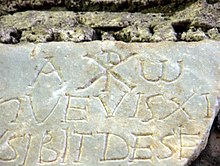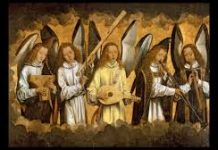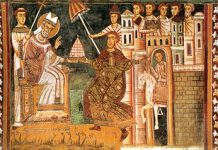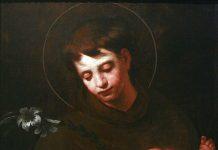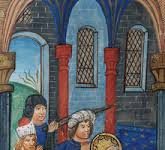We owe quite a lot to Pope Saint Damasus (305 – 384), who oversaw the universal Church during the tumultuous era of the lingering Arian crisis from 366 to his death in good old age in 384. It was he who approved the decrees of the Council of Constantinople in 381 which condemned the pernicious Arian heresy for the second time, and promulgated the great Niceno-Constantinopolitan creed which we recite – or sing! – at Sunday Mass. Credo in unum Deum! Belt it out, like you mean it.
Damasus is perhaps best known for commissioning Saint Jerome, his secretary, in 382 to compile the first true ‘official’ Bible, the Latin Vulgate. Jerome dedicated his own long life to sifting and translating the vast array of original sources in Hebrew and Greek, in which, through hard labour, he had made himself fluent.
 Damasus had already promulgated the official canon of Scripture at the Council of Rome in the same year: His De libris recipiendis et non recipiendis, ‘the books that should be received, and not received’, is identical with that of the much later decree of the Council of Trent in 1546, which set this canon for all time, contrary to Luther and the Protestants, who wanted to remove some books that were ‘inconvenient’ to their doctrine of sola Scriptura, sola fide and sola gratia. The Bible as we know it really is a Catholic book – universal and timeless – whose origins are divine, but whose versions and translations require careful scholarship, research and Magisterial authority.
Damasus had already promulgated the official canon of Scripture at the Council of Rome in the same year: His De libris recipiendis et non recipiendis, ‘the books that should be received, and not received’, is identical with that of the much later decree of the Council of Trent in 1546, which set this canon for all time, contrary to Luther and the Protestants, who wanted to remove some books that were ‘inconvenient’ to their doctrine of sola Scriptura, sola fide and sola gratia. The Bible as we know it really is a Catholic book – universal and timeless – whose origins are divine, but whose versions and translations require careful scholarship, research and Magisterial authority.
As one of Damasus’ contemporary bishops, Augustine of Hippo, put it: But I would not believe in the Gospel, had not the authority of the Catholic Church already moved me. (cf., CCC, 119)
And while we’re at it, Pope Damasus is also the Pope who oversaw the transition of the whole Roman liturgy – that is, the Mass and sacraments – from Greek to Latin, which is still the official language of the Church, if all too rarely heard, in her doctrine, liturgy and prayers, immersed in immemorial Tradition. One of the last things Pope Saint John XXIII promulgated, on the very eve of the Second Vatican Council, was the Apostolic Constitution Veterum Sapientia, on February 22nd, 1962 – a brief, but profitable, read. Therein, the Holy Father ordered that Latin be preserved in seminaries and liturgies, and as the official language of the Church. The preservation of Latin in liturgy, by the way, was also decreed by the Council itself.
As a young boy, Damasus witnessed the legalization of Christianity under Constantine in February of 313 after that battle on Milvian Bridge, and, as an old man, he saw the Faith made the official religion of the Empire in 380 under Emperor Theodosius, in the promulgation De Fide Catholica in the same month, February (the 27th to be precise). Quite the time to live. Coincidentally, this fourth day of December also marks the promulgation of the feast of Christ the King, with Pius XI’s encyclical Quas Primas of 1925. Society is, and must be, in some sense ‘Catholic’, governed by Christ and His truth, or it devolves eventually into chaos and disorder – we need not look far for examples.
There were numerous scurrilous rumours of Damasus, the violent nature of his election, his conduct as Pope – most likely what we would now call fake news, as he was constantly hounded by the anti-Pope, Ursinus, who had apparently lost his faith, drifting over to Arianism.
Behind all this, the legacy of Damasus’ echoes through the ages, a pious and holy man, devoted to his religion, a great foe of the au courant heresies, against all those who denied Christ’s divinity, often with ambiguous and misleading language; Apollinarianism, which denied that Christ had a true human soul; and Macedonianism, which denied the divinity of the Holy Spirit. Damasus sent legates to the Council of Constantinople in 381, to ensure these heresies died the death they deserved, and the truth proclaimed and defined for all time.
Damasus also fostered devotion to the martyrs and their relics, opening up access to the catacombs – still a hugely popular attraction in Rome – signifying our incarnational as well as spiritual link not only to Christ, but to our ancestors in the Faith. One of his own favorite saints was the deacon, Lawrence, who had been martyred in the previous century, in 257, during the Decian persecution, a few days after Pope Sixtus II and some of his companions. Damasus bulit the magnificent Basilica Papale di San Lorenzo fuori le mura, to house his relics, which still stands to this day and which this author has visited more than once. I was nearly locked inside, while praying in the crypt of Lawrence’s tomb. Not that I would have minded all that much.
All in all, Damasus is one of the greatest of Popes, and it’s ironic that his own tomb is lost to history. He would likely have preferred it that way, as we honour this all-too-unknown and under-appreciated Pontiff, to whom we have much to thank, for the Vulgate Bible, the Latin Mass, and our devotion to saints. In this Advent season of watching and waiting, we should nurture and solidify in our own hearts and minds the Faith he handed on, for whose labours we should offer eternal gratitude and praise.
Have hope, dear reader, for God’s holy Catholic Church, as Daniel’s interpretaton of Nebuchadnezzar’s dream attests, is far greater than any given era or regime, and will endure unto the end of time, and Christ’s glorious Parousia. What is, is what has been, but what will be, exceeds our imagination or expectation.
Pope Saint Damasus, ora pro nobis et pro ecclesia! +

